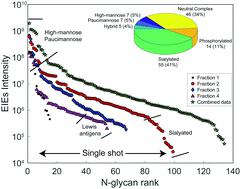当前位置:
X-MOL 学术
›
Mol. Omics
›
论文详情
Our official English website, www.x-mol.net, welcomes your feedback! (Note: you will need to create a separate account there.)
Quantitative capillary zone electrophoresis-mass spectrometry reveals the N-glycome developmental plan during vertebrate embryogenesis.
Molecular Omics ( IF 2.9 ) Pub Date : 2020-02-26 , DOI: 10.1039/d0mo00005a Yanyan Qu 1 , Kyle M Dubiak 1 , Elizabeth H Peuchen 1 , Matthew M Champion 1 , Zhenbin Zhang 1 , Alex S Hebert 2 , Sarah Wright 1 , Joshua J Coon 2 , Paul W Huber 1 , Norman J Dovichi 1
Molecular Omics ( IF 2.9 ) Pub Date : 2020-02-26 , DOI: 10.1039/d0mo00005a Yanyan Qu 1 , Kyle M Dubiak 1 , Elizabeth H Peuchen 1 , Matthew M Champion 1 , Zhenbin Zhang 1 , Alex S Hebert 2 , Sarah Wright 1 , Joshua J Coon 2 , Paul W Huber 1 , Norman J Dovichi 1
Affiliation

|
Glycans are known to be involved in many biological processes, while little is known about the expression of N-glycans during vertebrate development. We now report the first quantitative studies of both the expression of N-linked glycans at six early development stages and the expression of N-glycosylated peptides at two early development stages in Xenopus laevis, the African clawed frog. N-Glycans were labeled with isobaric tandem mass tags, pooled, separated by capillary electrophoresis, and characterized using tandem mass spectrometry. We quantified 110 N-glycan compositions that spanned four orders of magnitude in abundance. Capillary electrophoresis was particularly useful in identifying charged glycans; over 40% of the observed glycan compositions were sialylated. The glycan expression was relatively constant until the gastrula–neurula transition (developmental stage 13), followed by massive reprogramming. An increase in oligomannosidic and a decrease in the paucimannosidic and phosphorylated oligomannosidic glycans were observed at the late tailbud stage (developmental stage 41). Two notable and opposing regulation events were detected for sialylated glycans. LacdiNAc and Lewis antigen features distinguished down-regulated sialylation from up-regulated species. The level of Lewis antigen decreased at later stages, which was validated by Aleuria aurantia lectin (AAL) and Ulex europaeus lectin (UEA-I) blots. We also used HPLC coupled with tandem mass spectrometry to identify 611 N-glycosylation sites on 350 N-glycoproteins at the early stage developmental stage 1 (fertilized egg), and 1682 N-glycosylation sites on 1023 N-glycoproteins at stage 41 (late tailbud stage). Over two thirds of the N-glycoproteins identified in the late tailbud stage are associated with neuron projection morphogenesis, suggesting a vital role of the N-glycome in neuronal development.
中文翻译:

定量毛细管区带电泳质谱法揭示了脊椎动物胚胎发生过程中的N-糖基发育计划。
已知聚糖参与许多生物学过程,而关于脊椎动物发育过程中N-聚糖的表达知之甚少。现在,我们报道非洲爪蛙Xenopus laevis在六个早期发育阶段的N-连接聚糖的表达和在两个早期发育阶段的N-糖基化肽的表达的首次定量研究。用等压串联质谱标签标记N-聚糖,合并,通过毛细管电泳分离,并使用串联质谱进行表征。我们量化了110 N-聚糖成分的丰度跨越了四个数量级。毛细管电泳在鉴定带电荷的聚糖方面特别有用。超过40%的观察到的聚糖成分被唾液酸化。聚糖表达相对恒定,直到胃-神经管转变(发育阶段13),然后进行大量重编程。在尾部花蕾后期(发育阶段41)观察到寡甘露糖苷的增加,以及低聚甘露糖苷和磷酸化的寡甘露糖苷的聚糖的减少。检测到两个显着和相反的唾液酸化聚糖调节事件。LacdiNAc和Lewis抗原的特征是唾液酸化的下调和物种的上调。Lewis抗原的水平在后期降低,这已被Aleuria aurantia验证凝集素(AAL)和欧洲油菜素凝集素(UEA-1)印迹。我们还使用了HPLC和串联质谱,在早期发育阶段1(受精卵)中鉴定了350 N-糖蛋白上的611 N-糖基化位点,并在第41阶段(后尾花蕾)上鉴定了1023 N-糖蛋白上的1682 N-糖基化位点。阶段)。在三分之二ñ后期tailbud阶段-glycoproteins鉴定与神经元投射形态相关,这表明的重要作用ñ -glycome神经发育。
更新日期:2020-02-26
中文翻译:

定量毛细管区带电泳质谱法揭示了脊椎动物胚胎发生过程中的N-糖基发育计划。
已知聚糖参与许多生物学过程,而关于脊椎动物发育过程中N-聚糖的表达知之甚少。现在,我们报道非洲爪蛙Xenopus laevis在六个早期发育阶段的N-连接聚糖的表达和在两个早期发育阶段的N-糖基化肽的表达的首次定量研究。用等压串联质谱标签标记N-聚糖,合并,通过毛细管电泳分离,并使用串联质谱进行表征。我们量化了110 N-聚糖成分的丰度跨越了四个数量级。毛细管电泳在鉴定带电荷的聚糖方面特别有用。超过40%的观察到的聚糖成分被唾液酸化。聚糖表达相对恒定,直到胃-神经管转变(发育阶段13),然后进行大量重编程。在尾部花蕾后期(发育阶段41)观察到寡甘露糖苷的增加,以及低聚甘露糖苷和磷酸化的寡甘露糖苷的聚糖的减少。检测到两个显着和相反的唾液酸化聚糖调节事件。LacdiNAc和Lewis抗原的特征是唾液酸化的下调和物种的上调。Lewis抗原的水平在后期降低,这已被Aleuria aurantia验证凝集素(AAL)和欧洲油菜素凝集素(UEA-1)印迹。我们还使用了HPLC和串联质谱,在早期发育阶段1(受精卵)中鉴定了350 N-糖蛋白上的611 N-糖基化位点,并在第41阶段(后尾花蕾)上鉴定了1023 N-糖蛋白上的1682 N-糖基化位点。阶段)。在三分之二ñ后期tailbud阶段-glycoproteins鉴定与神经元投射形态相关,这表明的重要作用ñ -glycome神经发育。


























 京公网安备 11010802027423号
京公网安备 11010802027423号